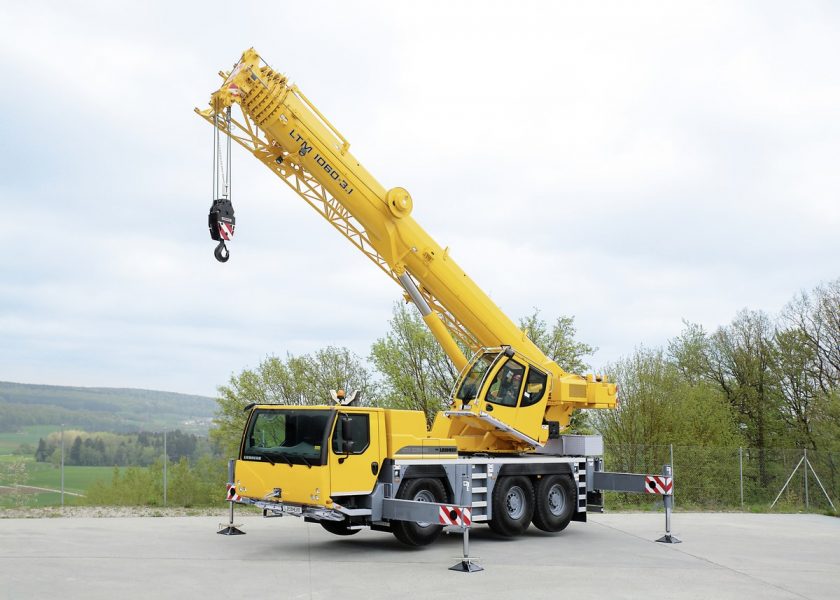For centuries, humankind has built impressive structures using various methods to lift heavy objects and bring them where they were needed. From Stonehenge to the Pyramids of Egypt, the world has many examples from long ago where impressive structures were built, most likely thanks to things like sledges, ropes, ramps, levers, and, perhaps, rudimentary cranes.

Today there are many cranes used around the world to lift and move heavy objects. One type of crane is the hydraulic crane, which is used for hoisting and lifting objects. Unlike smaller cranes, this heavy-duty crane utilizes a fluid-filled hydraulic system to move very heavy loads, like shipping containers and tractor trailers.
The Components of a Hydraulic Crane
Typically, a hydraulic crane has an enclosed operator’s cab atop a steel base. From the cab, the operator controls a large arm, known as a boom or telescoping boom, which extends quite a long way out. Thanks to the use of blocks, cables, hooks and other equipment, hydraulic cranes are useful for “the big jobs.” In some cases, they’re mounted on top of a chassis with wheels/rollers so they can move as needed.
The Power of a Hydraulic Crane
Where does the crane get its power? It comes from a hydraulic pump. This pump applies pressure to a fluid (or oil) within the system. This applied force gets transferred to where it’s needed in order to lift objects. Depending on the project, hydraulic cranes can handle certain loads based on their total lifting capacity. For example, a 10-ton crane can lift up to 10 tons safely– but anything heavier than that could cause the crane to fail. Obviously, those who operate hydraulic cranes should have lots of safety training so no one gets hurt. These cranes are usually large and very powerful.
The Inventor of the Hydraulic Crane
Who invented the hydraulic crane? Well, for starters, go back to the 1400s. It was then that Blaise Pascal helped society understand hydraulic principles which would influence how modern hydraulics developed ever since… Trivia bonus: Pascal invented the hydraulic press.
Fast forward to the 1800s, when industrialization and ironworks became the norm. Cranes went from being made of wood to being made of iron. In 1834, a cast iron crane was invented. In the 1850s, hand-powered cranes switched over to steam power. All these developments were baby steps toward the beginning of truly hydraulic cranes for use in everyday life.

So, imagine you were alive in the early 1940s and you worked for Milwaukee Hydraulics Corp. Roy Billings worked there, and he had the mind of an entrepreneur and an inventor. At the time, heavy friction-operated cranes were typical, but Billings thought, “What about a smaller, more mobile crane that would be safer to operate and cheaper to make?” Billings brought together the use of high pressure hydraulic systems with cranes, building a truck-mounted hydraulic crane with a telescopic boom. The crane also had hydraulically operated outriggers. In 1946, the “H-2” aka “Hydrocrane” launched as one of America’s first ever hydraulic cranes for sale. Some 200 of them sold in the first year alone!
The First Mass Market Hydraulic Crane
What was the first “mass market” hydraulic crane like? The H-2 Hydrocrane could be mounted on a 2-ton truck and could lift up to 2 tons with an 8-foot radius. Pumps were driven by a power take-off from the truck’s engine. A set of vertical hydraulic rams between sheave blocks (extending and retracting cables) allowed for the hoist motion to happen. And all of this could be controlled from the cab where the operator controlled all the motions– even the outriggers.
Milwaukee was where hydraulic cranes were born in the 1940s. Soon, the Bucyrus-Erie Co. in South Milwaukee purchased the Milwaukee Hydraulics Corp. (in 1948) and took the H-2 to new levels. By 1953, the H-3 was developed, including a truck-mounted backhoe (a Hydrohoe), followed by 1955’s H-5, which could handle 9 tons at the time.

The H-3 and H-5 were so successful that Bucyrus-Erie Co. (later renamed Bucyrus International) kept them in their product line until 1981! As you’d imagine, improvements were made over the years, with the H-3 eventually handling up to 5 tons capacity, and the H-5 up to 15 tons. Hydraulic cranes have come a long way since the 1940s, and today they’re more popular than ever.
Hydraulic Cranes for Rent
Do you need to rent a hydraulic crane that can handle up to 600 tons? Astro Crane of New England rents hydraulic cranes ranging from 6 to 600 tons. Providing service all over New England, Astro Crane has an extensive, well-maintained fleet. For more info, please call 978-429-8666 or use our contact page here.

